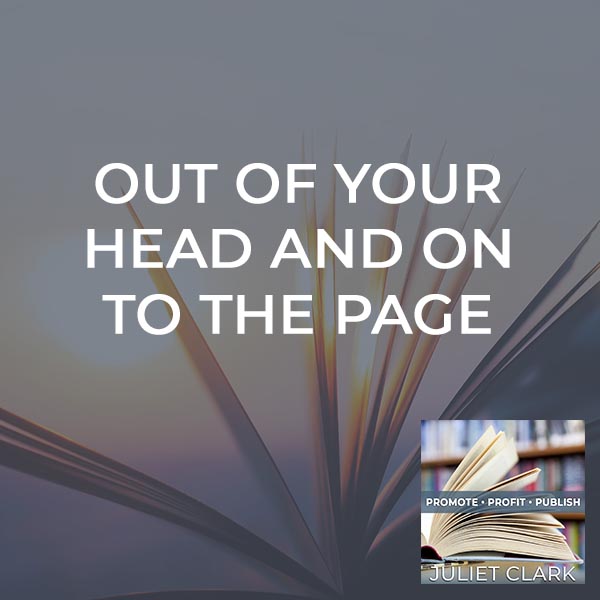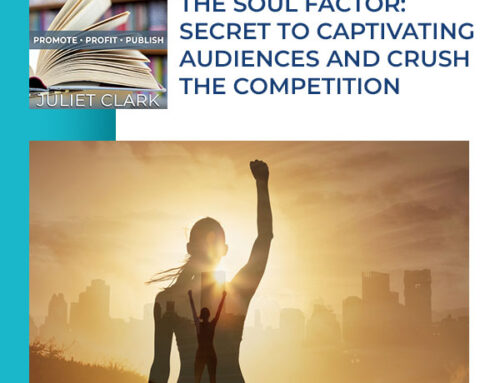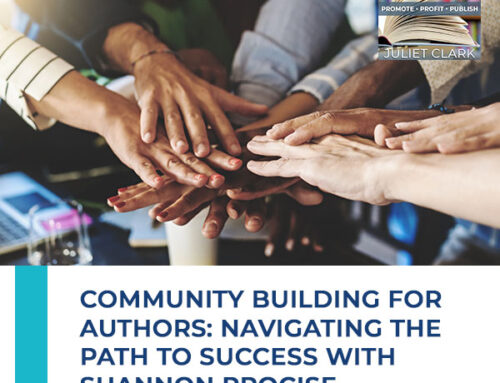
We can’t just think a book into existence. Our ideas should not just float around; they need to arrive on the page. This may seem easier said than done. Fortunately, you have a book developer on your side in today’s episode. Kristy Boyd Johnson joins Juliet Clark to help us take those book ideas out of your head and on to the page. Kristy is an award-winning children’s author and sought-after developmental editor and transformational book coach. She brings her expertise to guide us step-by-step on how to develop a book—from sifting through book ideas to writing to editing. Be it nonfiction or fiction, Kristy has you from cover to cover to help you complete your book. Learn the ins and outs of book development now!
—
Listen to the podcast here
Out Of Your Head And On To The Page
From Book Idea To Writing
Before we get started, I want to send you over to grab a copy of my new book, The Author Success Handbook. If you want to build a platform, there is a step-by-step way to do it that maximizes results. If you’ve tried to do this before, it’s piecemeal, it doesn’t make sense, and it’s not working for you, chances are that you haven’t done it in a way that lays the foundational tools first so that you can build upon them. If you want to grab a copy of it, go over to AuthorSuccessHandbook.com and you’ll find it on Amazon.
Our guest is Kristy Boyd Johnson. I always call her Kris. Kris is one of our editors and book developers that we work closely with to make sure that we have the best quality books out there. She is an award-winning children’s author and has ghostwritten over 30 books for entrepreneurs over the years. She is a sought-after developmental editor and transformational book coach.
She launched Starseed Journey Retreats because she can’t imagine anything better than going to a beautiful location with beautiful people who want to reconnect with their deepest selves through writing. I agree. Who wouldn’t want to do that? You can get a lot of writing done when you walk away from the family in the daily grind and just put yourself in a beautiful location where you don’t have any outside interruptions. Stay tuned for our interview with Kris.
—
Welcome Kris, it’s great to have you on the show.
Thank you, Juliet. I am so thrilled to be here. It’s always awesome.
I want to talk a little bit more about book development because when this comes out in August 2023, that’s the time that entrepreneurs or pretty much everyone starts thinking about, “What am I going to put together? What is going to be my accomplishment in the next year?” If you’re thinking about writing a book, you have to start thinking about, “Am I going to be serious about it? Is it a 2024 goal? What do I need to do for my next steps?”
The first step in this process is about hiring a book developer and taking the idea out of your head and getting it onto paper in a cohesive, understandable manner. Let’s start with non-fiction. How do you do that? Let’s say I have an idea for a book called The Author Success Handbook. I come to you and I say, “Kris, I got this idea. I don’t know if anybody will read it.” What I’d like to do is put together something so that they know the order of it, like a step-by-step guide. How do we do that? Take me through the process of how you would work with that.
First of all, that’s quite a well-thought-out plan, to begin with. Many authors don’t even start with that. They just have this idea for a book floating around, and it’s not well-defined. It’s just a general idea. The first thing that most people have to do is they have to get clear on what exactly it is they want to talk about in their book.
For non-fiction, especially for entrepreneurs who are building a business around it, that requires focus. It requires you to sit down and get clear about it because there are probably about a million ideas. Putting a million ideas in a book, first of all, is not a marketable thing. You have to focus on and you also want to make it reader-friendly.
It is deciding, “What is it I want to talk about and how do I want to approach it?” You already have the idea that you want to do a step-by-step guide. We have an approach already. That’s amazing. That’s a huge leap forward. The first step, if we back up a little, is how you want to approach it. Is it a how-to-guide? Is it step by step? Is it general information? Is it some kind of strategy for your audience? Is it informational to help educate them?
You have to get there. Usually, that’s the first conversation I have with a client. They come to me with a vague idea and we have to get clear. We also have to get clear on who we are talking to. I’m sure that you as a publisher have experienced that my-book-is-for-everybody phenomenon, “Everybody needs to read my book.” No.
In fact, it’s very interesting. We took on somebody in March 2023. He brought me the book and I had him go through the Build Your Author Avatar Program. He went back to the drawing board with his book developer because they didn’t define that well enough. I had them also read Why They Buy. He had no idea about the different archetypes for why people buy. He went back to the drawing board to make changes to the book because it was written for everyone in a particular demographic, and he needed to get it down and niche a little bit more.
I come to you and I have this idea. I know who my audience is. What are our next steps? I know there’s some storytelling in there. You and I have experienced that storytelling usually goes at the beginning someplace. You have to be able to tell your story efficiently without a whole book of victimhood. Usually, when you’re trying to do this, you’re trying to be inspirational. You’re telling your story, and people resonate with it, but then you have to move on to the inspirational stuff and how you’re going to help them.
Yes, the personal journey story of the author of, “How I got to this place to write this book,” also includes a little bit of what makes me someone you should listen to when you read this book. It is the first thing I have them do. I, personally, am a big believer in what we affectionately call the vomit draft, which is a way of bypassing that inner critic of who’s going, “You can’t do this. Who are you to write a book? No one’s going listen to you.” We have to get that voice to shut up.
The way to do it is to say, “We’re going to start easy. We’re going to just talk about you. You’re going to tell me your story. You’re going to tell me how you got here, and you’re going tell me why you want to write this book.” In the course of doing that, you’re going to get it all down on paper. That’s the only thing. When that voice rears its ugly head, you say, “Don’t edit before editing.” When you’re in writing, be in writing. Editing comes way later. That’s essentially what writer’s block is. You start editing yourself before you’re through writing, and then it just shuts you down. Get that story down. If we’re working with me, then we go through that. We can do some fine-tuning. We can get really clear. We can take out anything that seems victimy, extraneous or doesn’t apply and we focus on it.
When you’re in writing, be in writing. Editing comes way later. Share on XI have a strategy that I teach. In fact, I have a workshop coming up in August 2023, where I’m going teach people the strategy of a fun and easy way to outline the book. One of those things is that you want to think about the experiences you’ve had in your business. Chances are you had about 99.9% of the funny stories happen in your business. You’ve had serious stories happen in your business, depending on what the business is you could have, excellent, anecdotal stories about how successes, not just testimonials, but actual case study type thing. It depends on what it is you’re writing about.
We make sure we figure that out. The way to figure it out isn’t to just bomb your reader with everything all at once. We want to make sure we weave it in. That’s one of the big advantages of working with a book developer. We go, “The next step, I want you to do this.” It seems very easy. When I worked with Sam Eaton, we went through the process. He would send me each chapter as she did it and I edited it.
We put it together in the first draft, then we went through it and we lined it all up. We were done in five months, the raw idea to finish the manuscript to you for publishing in five months, which is very good. Many people there, like, “I’ve had this idea for years.” “Let’s make it real.” It doesn’t have to take you three years to write a book. It can take you five months. That’s one of the beauties of working with someone like me who knows how to put a book together and knows how to guide you through the process.
It can keep you on task as well. One of the other things that you and I encountered is when somebody’s writing a self-help book, there is that narrative or that story at the beginning where you share, but then the book has to be about healing. We experienced a book that was about suicide and it was all about the author, not all about how you could avoid these situations and help.
Another thing that you do as well is go back. You’re that critical eye. You guys have to remember. Editors always use red. It seems critical at the time. I don’t know if I ever told you this, Kris, but my very first book was edited by Stephen King’s first editor. It wasn’t a send-it-to-me-on-a-disc or a send-it-via-email. I had to print out the manuscript and mail it to him. When I opened it up on the mail back, I was just about in tears. There was so much red there.
That’s true. That does happen. You do have to be ready for that. It happens less if you work with a developer from the beginning. When we get to editing, it’s a lot of fine-tuning and it’s not so much of the slitting open your wrists and then bleeding all over the page phenomenon.
That was the point where I learned that I was a good storyteller, but not so great a writer.
That phenomenon happens too. The author I’m working with has the story and then I edit a lot to help them communicate it in a way that’s clear. I can’t tell you how many times I’ve called a client and said, “I’m on page 42 in this paragraph. Do you mean this, or do you mean that? You could interpret this.” I then have to get clear with them so that I can fix it and make it communicate. Sometimes it comes across in a way you do not want to communicate.
Exactly. One of the things I tell my authors all the time is, “You may be a writer, but you’re probably not a copywriter.” I’m a good storyteller, I’m a better copywriter than I am an actual writer, but I can tell a story. You have to go into a deep dive about what your strengths are and your weaknesses are here because most of the time you are not both.
That’s true most of the time. There are people out there who just want to hand the book to a ghostwriter, which is fine. That’s a good option. I’ve ghostwritten a number of books, which I’ve moved away from. The difference is that people think the ghostwriter just waves a wand and magically makes it. No, you have to work really closely with that ghostwriter because they’re not in your head. It’s harder because they have to pull the information from you in. With development, you can put it down on paper and then we can work together to finesse it, make it flow, make it read right, and communicate what you want to communicate.
Ghostwriting is hard not only because you have to do that research, but you have to use the author’s voice. If I’m the author, it’s my voice. I know Kris hates editing my books because my voice is short and sweet and to the point. It’s like, “This book will be ten pages.”
I like editing your books because you are like that. It’s easier to flush out a little bit and add some detail, especially since I know you so well and I already know what you’re thinking. It’s easier to do that than to wade through a bunch of extraneous information and then have to explain to the author that they don’t have to repeat themselves eighteen times that once was enough. That’s very difficult because they feel like you’re cutting out all the good parts of their book. It’s like, “No, you’re overwhelming your readers with too much information and you’re repeating yourself over and over.” “It’s from my soul.” “Can we just communicate that soul one time?”
We always have to be thinking about the reader. Writing the book is about the author. Reading the book is about the experience of the reader. The book itself is for the reader. It’s all about the reader’s experience. We want to stay focused on what they’re getting out of it because when they read it, we want them to come to you for your business. We want to help you build an audience. If it’s all about you, like that suicide book where the author wrote all about him, his feelings, and what he did, it came across as this self-aggrandizing, “Look at me. I went through this heroic thing,” and it just fell flat. It just didn’t work.
Writing the book is about the author. Reading the book is about the experience of the reader. The book itself is for the reader. Share on XNow that we’ve established that my books are short and sweet and I have no soul, let’s move on.
That’s the beauty of your books, Juliet. They’re you, then we just add stuff in to make it a little clearer for the audience, who might not know everything you know because you’re brilliant.
Thank you. Let’s move on to fiction because you also have a fiction workshop coming up. Guys, fiction is so fun to write, but finding an audience can be different. You have to build effective characters. You guys are going to hear this on next week’s episode too because I just did it. It’s funny. My son is writing his first fiction novel. We’re having a discussion in the kitchen. My daughter and my son-in-law are there. Tyler is telling us about this character in his book. She is a demi-human.
All of a sudden, my son-in-law, who reads a lot of fantasy, says, “You have furries in your book?” There is this brawl in my kitchen about, “She’s not a furry.” “She sounds like a furry to me.” My daughter actually said this. “Who’s going to read your book? Are you going to go to furry conferences to sell it?” You got to be really good. Otherwise, people are going to think your characters are something they’re not.
That’s true. Characters have to be very well-drawn. The typical problem I see with characters in fiction is that there’s way too much of the author in the character. I’m editing a fiction book now where the main character got this juicy premise, really brilliant. The character has this incredible gift. It’s messed her up. She’s drug seeking and doing coke to try to avoid this gift, trying to push her way through. She’s going to parties, having conversations, shopping, getting all this money, and searching for a historic home. There’s nothing about this gift pushing through and there’s no drug seeking in here. This character is beautifully rational, which is the author. The author is like that.
You have to think you’re not rational when you’re doing cocaine and drinking. You’re not a rational individual.
You got create problems, get in trouble, mess up other people’s lives, and have them hate you. That’s the juice of it.
There’s got to be drama and you sinking into the abyss of addiction at the same time.
One of the best tips I ever got about drawing a character is to give them a limp and an eyepatch. That means, what are the flaws that caused them to have some blindness about what’s going on around them and causes them to falter as they try to get through this journey? In the movie, Taken, the hero is a heroic figure who goes after the bad guys. You know that that’s what he is and he doesn’t really change, but the characters around him are flawed.

Book Development: Give characters a limp and an eyepatch. That means, what are the flaws that caused them to have some blindness about what’s going on around them and causes them to falter as they try to get through this journey?
There’s the fun in that. You can do it that way. You just have to draw your characters, especially the two main ones, the protagonists and antagonists. The incidental characters, you don’t have to worry about too much. An antagonist, the bad guy, the villain, you do not want them to be all bad because it comes off flat and two-dimensional. The best, if I can give about that is to remember that your villain is a hero in his own mind.
He thinks what he’s doing maybe is heroic. In one of the books I wrote, the villain, he’s this horrible human being. He thinks that when he goes after the main character, he’s doing something good for the world. He thinks that he’s saving the world from these people. It gives him dimension. Even though you’re reading, probably going, “Guy’s out of his mind,” that’s okay because you’re in the story rather than reading a flat character. That’s the best.
You have to remember most of those villains are sociopaths. They think they’re doing the right thing. Sociopaths always do. Kris, you have two workshops coming up. I’m participating in one of them because I’ve had a story forever that you’ve heard about. Everybody says that would be a great story, but I have not sat down and written it out. I’m going to be excited to do this too. I have written a mystery novel in probably many years because I got busy with business. Tell us about the workshops. What are they, when are they, and how can we sign up?
The first one is on August 5th, 2023. I’ll be at Zoom. Real easy, from 8:00 to 12:00 Central time. It’s a non-fiction workshop. It is not going to be me talking to you. It is going to be us working together to get you to put that book down on paper using my strategy to prep your book so that when you walk away from that four-hour workshop, you’ve got a solid outline to start working from. It’s $47. I wanted to do something easy for people to just get them to commit to themselves and to start that process with support from someone who knows what they’re doing. I want to help people. It’s not going to be me talking at people.
The fiction one is on August 19th, 2023. Both are Saturdays, incidentally. Also, on Zoom from 8:00 to 12:00 Central. That one’s a little different because the way you outline a fiction book is a completely different thing. What we’re going to do in that is we’re going to go through the structure. It’s called the narrative structure of your story.
I will say sometimes the antagonist is nature, like if it’s a man versus nature survival story or something. Nature’s the antagonist. That’s okay. It doesn’t matter. We’re going to build out that structure. It’s like a blueprint. You can create the blueprint any way you want to, but you have to have that structure in place. You can’t put a ceiling on before you have walls up.

Book Development: You can create the blueprint any way you want to, but you have to have that structure in place. You can’t put a ceiling on before you have walls up.
Most fiction writers falter because they get all excited and start writing, and then they go, “I don’t know where to go from here.” That’s because of the story. You’ve got to have the narrative structure built out first, then you can do pretty much whatever you want within the structure. We’re going to do that. Again, it is not me talking to you. You bring your stuff and we’re going to work on it there. We’re going to go through the process and you’re going to work on it. You leave there with something real to start with, to get you started. Also, it is $47 and hopefully a lot of fun. I am not really a serious person.
She has a good sense of humor. She is a serious person.
That’s true. I have a lighter personality.
Where’s the website? I want to add something to what you’ve just said about fiction.
The website is CrushYourExpertBook.com. Both of the workshops are there. It’s very easy. You’ll get an email back with all the information and the Zoom link and everything.
Here’s something fun. I want to mention that my son who’s been working with Kris for quite a while on this book went out the door with a 234,000 wordbook that we had to pare down in order to be able to publish it. You can do this too, this fiction workshop. We took Tyler’s book over to Fiverr and gave a guy over there that uses AI descriptions of the characters. He created the most beautiful character images for us to use in the writing process. This is something you can do too and put them on your wall and be inspired as you write the book. There are lots of people over on Fiverr who do AI and create this stuff now. If you’re going to do Kris’s workshop, take that next step and I’ll try to get her some links if she wants to recommend some of those people to them on it.
Another great tip to go with those pictures is to get a 3×5 card and put their character traits. Can I say the character’s name in Tyler’s book?
Sure.
There is Zanovia. It’s demi-human. What she looks like, her personality, her characteristics, what her struggles are, and what her flaws are, stick them up right under the picture.
You have to have that anyway for the people to create. When we got the first Zanovia back, Tyler was literally like, “I love the coat. The character’s a little bit too sexy.” You’re going to go back and forth and tweak from there as well. You need those 3×5 cards before you go over and have those people that they created over there. Kris, thank you for appearing on the show. I’ll probably talk to you later because I always talk to you.
I’ll be waiting for your call. Thank you so much for having me, Juliet. I’m looking forward to doing the workshops and meeting some awesome authors.
Important Links
- AuthorSuccessHandbook.com
- Starseed Journey Retreats
- Build Your Author Avatar Program
- Why They Buy
- CrushYourExpertBook.com
About Kristy Boyd Johnson
 Kristy Boyd Johnson is an award-winning children’s author, and has ghostwritten over 30 books for entrepreneurs over the years. She is a sought-after developmental editor and transformational book coach. She recently launched Starseed Journey Retreats because she can’t imagine anything better than being a beautiful location with beautiful people who want to reconnect with their deepest selves through writing.
Kristy Boyd Johnson is an award-winning children’s author, and has ghostwritten over 30 books for entrepreneurs over the years. She is a sought-after developmental editor and transformational book coach. She recently launched Starseed Journey Retreats because she can’t imagine anything better than being a beautiful location with beautiful people who want to reconnect with their deepest selves through writing.
Love the show? Subscribe, rate, review, and share!









Leave A Comment